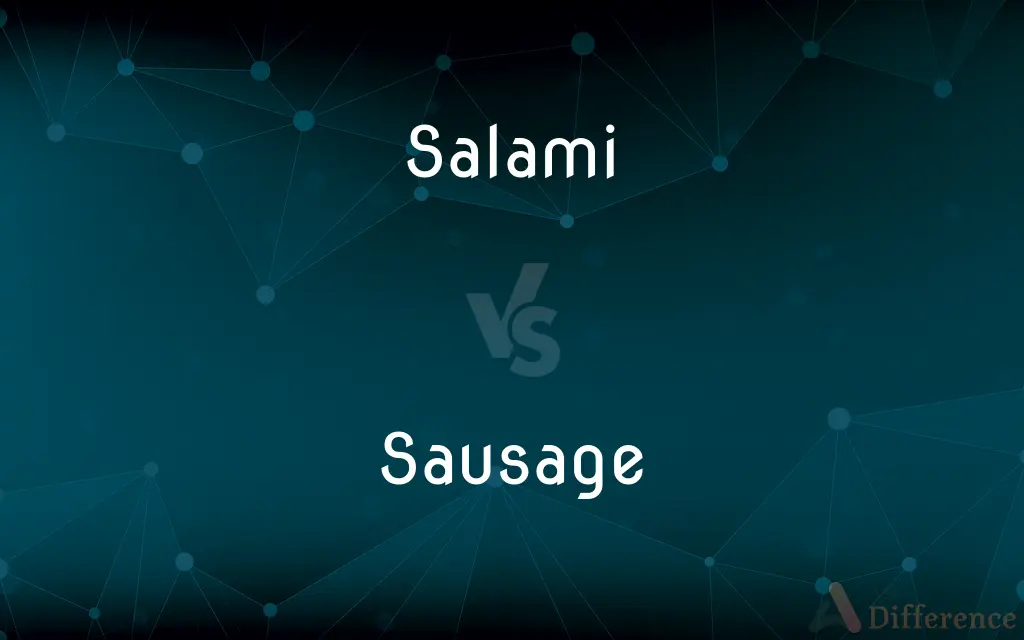Salami vs. Sausage — What's the Difference?
Edited by Tayyaba Rehman — By Fiza Rafique — Updated on November 6, 2023
Salami is a type of cured sausage consisting of fermented and air-dried meat, typically beef or pork. Sausage is a broader term for ground meat, which may be fresh, cooked, or cured, encased in skins or other materials and made in various lengths.

Difference Between Salami and Sausage
Table of Contents
ADVERTISEMENT
Key Differences
Salami is a specific type of sausage that is seasoned, fermented, and air-dried for a lengthy period to develop its distinctive flavor. Sausage, in contrast, is a general category of meat processed into a cylindrical shape, often encompassing a variety of preparation methods, including fresh, smoked, and cooked types.
The term salami is derived from the singular Italian salame, denoting a family of Italian cured meats. Sausages, however, have a global presence and are not confined to any one style or preparation, varying greatly across different cultures and cuisines.
Salami is known for its firm texture and strong taste, a result of the curing process and the spices used, which can include garlic, pepper, and wine. Sausages can range from the fine-textured and mild to coarse and highly spiced, with flavors and textures influenced by their ingredients and cooking methods.
While salami is usually eaten cold or at room temperature, often sliced thin and served as part of antipasti, sausages are more versatile, used in cooking stews, grilling, frying, or as a component in complex dishes.
Both salami and sausage play integral roles in various culinary traditions, with salami often associated with Italian cuisine and sausages found in nearly every culture around the world, from the German Bratwurst to the Mexican chorizo.
ADVERTISEMENT
Comparison Chart
Definition
A cured, fermented, and air-dried meat.
Ground meat encased in skin or other material.
Texture
Firm and dense due to drying.
Can vary from fine to coarse.
Flavor
Typically strong, tangy, and fermented.
Varies widely from mild to spicy.
Origin
Italian origins with a specific recipe.
Global variety with numerous recipes.
Consumption
Often eaten cold or at room temperature.
Can be eaten fresh, cooked, or cured.
Compare with Definitions
Salami
Fermented sausage with a distinct flavor.
(The salami had a robust garlic note.)
Sausage
A meat product available in various flavors.
(He grilled sausages for the barbecue.)
Salami
A seasoned meat preserved through air-drying.
(Salami is often added to pizzas for an extra zing.)
Sausage
Seasoned meat in a long, thin form.
(The sausage was spicy and well-seasoned.)
Salami
Dry sausage typically eaten cold.
(She packed salami for the picnic as it doesn't require refrigeration.)
Sausage
Encased ground meat, often pork.
(She added sausage to the stew for flavor.)
Salami
A firm-textured sausage ideal for slicing.
(The deli offered several types of salami.)
Sausage
A staple of breakfast in many cultures.
(Sausage and eggs are her favorite morning meal.)
Salami
Cured Italian sausage known for being air-dried.
(I sliced some salami for the charcuterie board.)
Sausage
Can be fresh, smoked, or cooked.
(They served smoked sausage at the dinner.)
Salami
Salami ( sə-LAH-mee) is a cured sausage consisting of fermented and air-dried meat, typically pork. Historically, salami was popular among Southern, Eastern, and Central European peasants because it can be stored at room temperature for up to 40 days once cut, supplementing a potentially meager or inconsistent supply of fresh meat.
Sausage
A sausage is a type of meat product usually made from ground meat, often pork, beef, or poultry, along with salt, spices and other flavourings. Other ingredients such as grains or breadcrumbs may be included as fillers or extenders.
Salami
Any of various highly spiced and salted sausages, made from beef or a mixture of pork and beef.
Sausage
An item of food in the form of a cylindrical length of minced pork or other meat encased in a skin, typically sold raw to be grilled or fried before eating.
Salami
A large cured meat sausage of Italian origin, served in slices.
Sausage
Used as an affectionate form of address, especially to a child
‘Silly sausage,’ he teased
Salami
(baseball) A grand slam.
Sausage
Finely chopped and seasoned meat, especially pork, usually stuffed into a prepared animal intestine or other casing and cooked or cured.
Salami
(slang) A penis.
Sausage
A small cylinder-shaped serving of this meat.
Salami
Highly seasoned fatty sausage of pork and beef usually dried
Sausage
A food made of ground meat (or meat substitute) and seasoning, packed in a section of the animal's intestine, or in a similarly cylindrical shaped synthetic casing; a length of this food.
Sausage
A sausage-shaped thing.
Sausage
Penis.
Sausage
(informal) A term of endearment.
My little sausage
Sausage
A saucisse.
Sausage
(engineering) To form a sausage-like shape, with a non-uniform cross section.
Sausage
An article of food consisting of meat (esp. pork) minced and highly seasoned, and inclosed in a cylindrical case or skin usually made of the prepared intestine of some animal.
Sausage
A saucisson. See Saucisson.
Sausage
Highly seasoned minced meat stuffed in casings
Sausage
A small nonrigid airship used for observation or as a barrage balloon
Common Curiosities
Does salami need to be refrigerated?
Yes, after cutting, salami should be refrigerated.
Are sausages pre-cooked when purchased?
Sausages can be bought fresh, pre-cooked, or smoked.
Are there vegetarian sausages?
Yes, vegetarian sausages are made from plant-based ingredients.
What meats are used in salami?
Salami is typically made from beef or pork.
Can sausage be made from poultry?
Yes, sausage can be made from chicken or turkey.
Is salami always cured?
Traditional salami is cured and air-dried.
Can salami be cooked?
While usually eaten cold, salami can be cooked.
Can you freeze sausage?
Yes, sausage can be frozen to extend its shelf life.
Is pepperoni a type of salami?
Yes, pepperoni is an American variety of salami.
What is the casing on sausage made from?
Sausage casing can be made from intestines or synthetic materials.
Is sausage suitable for a gluten-free diet?
Some sausages are gluten-free, but it’s important to check the ingredients.
Are there low-fat salami options?
Some manufacturers offer lower-fat versions of salami.
How long does salami last once opened?
Opened salami can last for up to three weeks if refrigerated.
How is sausage traditionally served?
Sausage is often grilled, fried, or used in recipes like casseroles.
Do both salami and sausage contain nitrates?
Many types of salami and sausages contain nitrates, but nitrate-free options are available.
Share Your Discovery

Previous Comparison
Force vs. Intensity
Next Comparison
Peal vs. PeelAuthor Spotlight
Written by
Fiza RafiqueFiza Rafique is a skilled content writer at AskDifference.com, where she meticulously refines and enhances written pieces. Drawing from her vast editorial expertise, Fiza ensures clarity, accuracy, and precision in every article. Passionate about language, she continually seeks to elevate the quality of content for readers worldwide.
Edited by
Tayyaba RehmanTayyaba Rehman is a distinguished writer, currently serving as a primary contributor to askdifference.com. As a researcher in semantics and etymology, Tayyaba's passion for the complexity of languages and their distinctions has found a perfect home on the platform. Tayyaba delves into the intricacies of language, distinguishing between commonly confused words and phrases, thereby providing clarity for readers worldwide.














































